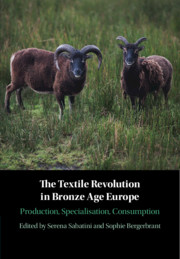Book contents
- The Textile Revolution in Bronze Age Europe
- The Textile Revolution in Bronze Age Europe
- Copyright page
- Contents
- Figures
- Tables
- Contributors
- Preface and Acknowledgements
- One Textile Production and Specialisation in Bronze Age Europe
- Two The Wool Zone in Prehistory and Protohistory
- Three Weaving in Bronze Age Italy: the Case of the Terramare settlement at Montale
- Four Loom Weights in Bronze Age Central Europe
- Five Textiles Remains in Polish Iron Age BI-RITUAL Cemeteries
- Six To Let Textiles Talk: Fibre Identification and Technological Analyses of Prehistoric Textiles from Denmark
- Seven The Challenge of Textiles in Early Bronze Age Burials: Fragments of Magnificence
- Eight Textile Ceramics as a Complement to Textile Research
- Nine Prehistoric Transhumance in the Northern Mediterranean
- Ten Wool Production and the Evidence of Strontium Isotope Analyses
- Eleven Wool Textiles in the Early Nordic Bronze Age: Local or Traded?
- Twelve Archaeological Wool Textiles: A Window into Ancient Sheep Genetics?
- Thirteen Skin, Furs, and Textiles: Mass Spectrometry-based Analysis of Ancient Protein Residues
- Fourteen Wool in the Bronze Age: Concluding Reflections
- Index
- References
Eleven - Wool Textiles in the Early Nordic Bronze Age: Local or Traded?
Published online by Cambridge University Press: 20 November 2019
- The Textile Revolution in Bronze Age Europe
- The Textile Revolution in Bronze Age Europe
- Copyright page
- Contents
- Figures
- Tables
- Contributors
- Preface and Acknowledgements
- One Textile Production and Specialisation in Bronze Age Europe
- Two The Wool Zone in Prehistory and Protohistory
- Three Weaving in Bronze Age Italy: the Case of the Terramare settlement at Montale
- Four Loom Weights in Bronze Age Central Europe
- Five Textiles Remains in Polish Iron Age BI-RITUAL Cemeteries
- Six To Let Textiles Talk: Fibre Identification and Technological Analyses of Prehistoric Textiles from Denmark
- Seven The Challenge of Textiles in Early Bronze Age Burials: Fragments of Magnificence
- Eight Textile Ceramics as a Complement to Textile Research
- Nine Prehistoric Transhumance in the Northern Mediterranean
- Ten Wool Production and the Evidence of Strontium Isotope Analyses
- Eleven Wool Textiles in the Early Nordic Bronze Age: Local or Traded?
- Twelve Archaeological Wool Textiles: A Window into Ancient Sheep Genetics?
- Thirteen Skin, Furs, and Textiles: Mass Spectrometry-based Analysis of Ancient Protein Residues
- Fourteen Wool in the Bronze Age: Concluding Reflections
- Index
- References
Summary
This chapter assesses the evidence for textiles from the Early Nordic Bronze Age and aims to shed light on the origins of the surviving textile fragments and exchange networks involved.
- Type
- Chapter
- Information
- The Textile Revolution in Bronze Age EuropeProduction, Specialisation, Consumption, pp. 255 - 273Publisher: Cambridge University PressPrint publication year: 2019
References
- 2
- Cited by

